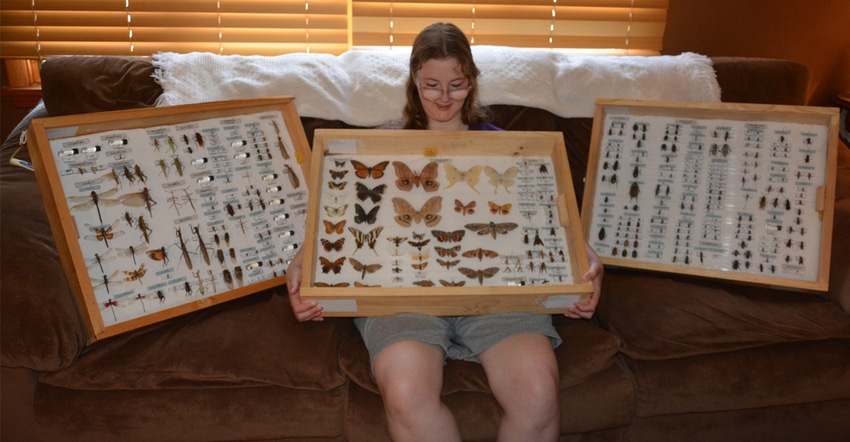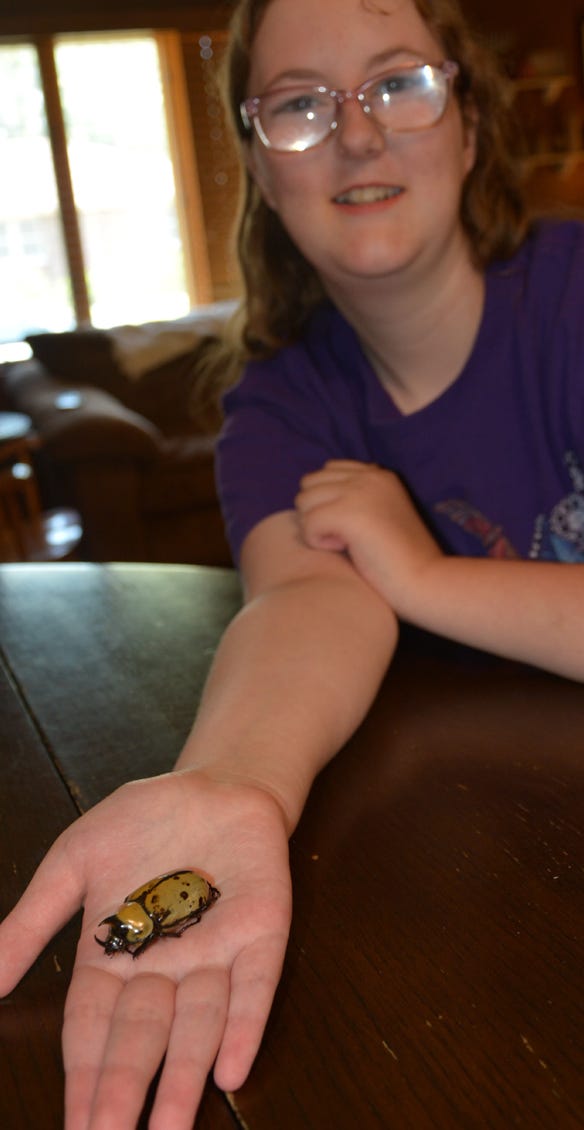
Ann Knoblauch is a girl who loves bugs. She has boxes of them in her mom’s home freezer to prove it.
“She’s been fascinated by them since she was just a little kid,” according to her mother, Renee.
Ann, now 16, joined 4-H as an 8-year-old because of her fascination with insects and the opportunity that doing an entomology project would provide her to learn more about the critters that she found so interesting.
In 4-H, she discovered whole shelves of books filled with pictures of insects and details about how they live, where to find them, how to catch them, how to pin them and how to do an entomology display. She flourished. At the 2018 Kansas State Fair, she won a purple ribbon for her entomology entry and was honored with the Kansas Award Portfolio in recognition of her work.
Ann, who has autism, found that her passion for insects provided her a route to expression and a way to engage with other people. This year, she is taking three boxes of bugs to display at the state fair. She is close to surpassing the 450-speciman limit on bug count.
“I’m hoping to do really good this year,” she said.
One of Ann’s earliest projects was beekeeping.
“I was terrified of bees,” Renee says. “We went to a workshop on beekeeping and Ann was just fascinated. After the workshop, they offered to give us a private tour. She was so excited that I tamped down my fear and agreed to it. They brought us out these outfits to put on and in we went. Ann actually had a bee get inside her hood and sting her, but she just flicked it away and kept going. The guide said ‘yep, she’s a beekeeper.’ And the result was we ended up with three hives of bees.”
Ann began selling honey and making lip balms, using her proceeds to make donations to organizations to help them raise money. One the primary beneficiaries was her therapeutic riding academy, Freedom Hooves Therapeutic Riding Center.
She has also made presentations at Heartspring, a nonprofit center for children with special needs located in Wichita. Ann helped with gardening classes for a homeschool group to identify beneficial and bad insects in the garden. In her 4-H Entomology class, she likes to help other 4-H’ers identify insects.
“I think it was her record book, where she wrote down everything she was doing and learning, and her outreach into the community that helped her win the KAP award,” Renee says.
Ann has become a recognized expert on insects and regularly gets requests for help with identifying a specimen. Her efforts in the community and through 4-H have resulted in a lot of people knowing her and her passion for bugs.
“They bring me bugs and send me bugs in the mail,” she said.
 HERCULES BEETLE: Ann Knoblauch holds an Eastern Hercules Beetle in her outstretched palm. The beetles are large and have horns. She said the beetle was sent to her by an acquaintance of her mom in Greenwood County who wanted her to identify it and said she could have it.
HERCULES BEETLE: Ann Knoblauch holds an Eastern Hercules Beetle in her outstretched palm. The beetles are large and have horns. She said the beetle was sent to her by an acquaintance of her mom in Greenwood County who wanted her to identify it and said she could have it.

One of the latest arrivals, an Eastern Hercules Beetle, came from Greenwood County. He was being prepared for pinning in the “hydrating chamber” while Ann, her mom and her brother, David, talked about her projects. The hydrating chamber was a simple plastic box with a locking lid that contained sand, water and a little disinfectant. And, of course the beetle.
“The bugs dry out and it’s hard to spread their legs or antenna for pinning,” Ann explained. “You have to make them softer.”
Ann concentrates primarily on capturing or displaying insects that are found in Kansas because to score in the Kansas State Fair entomology project, all specimens must be found in the state.
Her three boxes of insects now contain 429 specimens, separated according to order and family. She is still collecting new specimens and going though those she has in storage to replace any in the display that are of lesser quality than the new ones. She also gives some duplicates to other 4-H’ers who are looking for some of the more fragile, hard-to-capture bugs.
At her home in Cheney, she has planted a “pollinator-friendly” flower garden, a perfect spot for adding to her supply of bugs and helping the pollinators thrive, which is good for the environment.
“I have my limit of bees and wasps,” she said.
Ann has to keep her boxes stored well away from a couple of her favorite “friends,” the family cats, who find it amusing to break into the boxes and “catch” the specimens.
“Last year, the cat took out 25 or 30 bugs,” Renee said. “Now we make sure we keep the boxes in a safe spot.”
Ann said her favorites in the collection are moths, especially those of the silk moth family.
“They are pretty colors,” she said.
She is limited in how many she can display by the size of her boxes, which is dictated by state fair rules.
“You can have up to 450 specimens, but they have to be in a maximum of three boxes,” Renee said.
Ann will be at the fair to help with counting the insects in the incoming boxes of other 4-H’ers throughout the state to verify the numbers are correct in each entomology box. She said she likes helping in the 4-H building and seeing all the insects from across the state.
Ann is a member of the Cheney Challengers 4-H Club and also plans to exhibit one photo (of bugs, of course) in the photography project at the fair.
The Kansas State Fair opens Sept. 6 and runs through Sept. 15 at the state fairgrounds in Hutchinson.
About the Author(s)
You May Also Like






